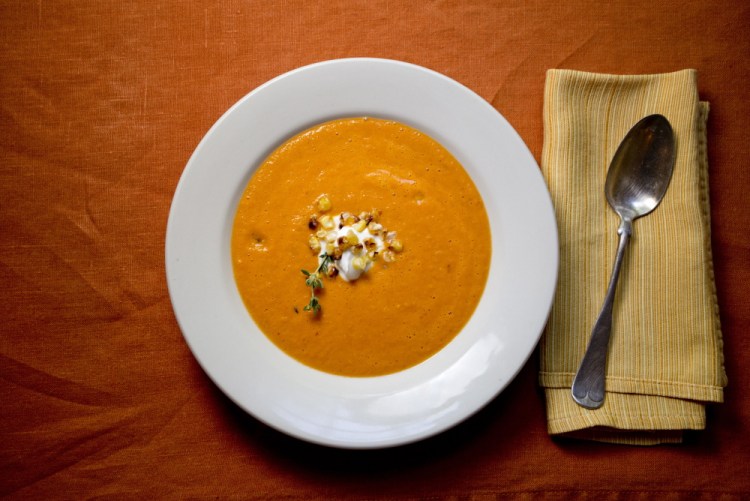Just about this time of year for the past eight, I’ve picked up 50 pounds of local tomatoes and put them up in various forms – canned whole, roasted and frozen, preserved as sauce, or jarred as juice – so my family can taste summertime in the dead of winter.
I’ve never been the type of preserver who could pass off any of these processes as easy. Typically, about halfway through the box of fruit – my curls tight to my head from the steamy water bath; my white cabinets streaked with orange residue I’ll never completely scrub off; and the ice bin emptied by the tomato skin removal process just as I become desperate for a cold drink – is when I start to question the wisdom of canning this many tomatoes.
Yes, it is indeed a wholesome venture. And certainly my efforts support my local food system. And I know they’ll taste great in the end.
But it ain’t cheap.
At my market, perfectly ripe, beautifully shaped Maine tomatoes cost $3.18 per pound on average. It takes 3 pounds to make a quart jar of canned tomatoes; about 3½ pounds to get 1 quart of either crushed tomatoes or tomato juice; and 5 pounds to yield a single jar of sauce.
Calculating the price of any canning project I take on always leaves me asking for seconds.
Seconds, in this sense, are the scraggly looking, extra-ripe, maybe slightly bruised produce that doesn’t quite make the farmers market grade, but are still absolutely edible, perfect for things like jam and sauce, and sold at a good discount.
Take, for example, the tomatoes available at the Brunswick market on the mall on Tuesdays and Fridays. Whatley Farm sells organic firsts for $3.75 per pound and their seconds at $2.50 per pound (a 33 percent discount). Spears Farm, running a special the week I checked prices, charges $1.99 per pound for conventionally raised firsts and sells 20-pound boxes of seconds for $15 (a 63 percent savings).
Cathy Barrow, author of “Mrs. Wheelbarrow’s Practical Pantry: Recipes and Techniques for Year Round Preserving,” is one of those preservers who makes processing food look easy. She says “seconds are going to be available whenever a crop has done well, especially mid/end of summer crops that come in all at once.”
For us in Maine this year, that means tomatoes, carrots, corn, apples, parsnips for sure, and maybe even some zucchini, eggplant, sweet peppers and pumpkins.
Tomatoes are widely advertised as seconds, but most of the farmers I asked are absolutely willing to sell you their seconds of other crops, you just need to ask.
ROASTED SECONDS SOUP
This soup can be made with just about any seconds – tomatoes, carrots, apples, squash, corn – you’ll likely be able to pick up from Maine farmers at peak season. Because you chop and roast these fruits and vegetables to intensify their flavors, and puree them to a pulp to finish the soup, they needn’t be picture perfect before going into the pot.
I typically use thyme as a unifying herb, but that is a personal preference, so feel free to experiment with flavor combinations while keeping the fruit/vegetable-to-stock ratio constant. I make a couple of batches with a single vegetable, but my favorite combinations are tomatoes and corn, and parsnips and apple.
To roast tomatoes, core them and cut them in half, cut-side down. Rub the tops with oil, sprinkle with salt and roast. The skins will wrinkle and char making them easy to pull off before adding the fruit to the soup.
Makes 2 quarts of soup (easily doubled or tripled if you’re putting some up)
6 cups peeled, cored and chopped farmers market seconds (carrots, tomatoes, apples, corn, winter squash, parsnips or a combination)
1/4 cup olive oil
Sea salt
1 medium sweet onion (such as Maui or Vidalia), chopped
2 large garlic cloves, roughly chopped
4 -5 cups vegetable stock or water
3 large sprigs fresh thyme, plus 1 teaspoon leaves for garnish
Yogurt, sour cream or crème fraîche for garnish
Freshly grated pepper
Preheat the oven to 400 degrees F.
Place the vegetables on a rimmed baking sheet, toss with 2 tablespoons of the olive oil, spread them into a single layer on the sheet and sprinkle them generously with salt. If you are using different types of vegetables in combination, it’s best to roast them on separate pans as roasting times will vary. Roast until vegetables are soft (between 25 and 45 minutes, depending on the vegetable) turning them with a spatula twice so they get caramelized on all sides.
Meanwhile, cook the onion in the remaining 2 tablespoons olive oil in a large pot until translucent, 3 to 5 minutes. Add the garlic and cook for 1 minute more. Pour in 4 cups of stock or water and toss in the thyme sprigs. Simmer this mixture for 10 minutes. Add the roasted vegetables and any juices that may have accumulated in the pan and simmer for 10 more minutes. Fish out the thyme sprigs (the leaves should have fallen off in the cooking process). Puree the soup until smooth, adding a little more stock or water if it seems thick. Add salt and pepper to taste. Serve hot, garnished with thyme leaves, a dollop of the dairy product of your choice and corn kernels if you have them.
Christine Burns Rudalevige is a food writer, recipe developer and tester, and cooking teacher in Brunswick. Contact her at cburns1227@gmail.com.
Send questions/comments to the editors.


